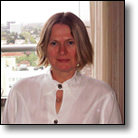Matyska-Pesek, Maria T

Lecturer AY-C, Chemistry
Preferred: maria.matyska-pesek@sjsu.edu
Telephone
Preferred: (408) 924-4939
RESEARCH
Students in Pesek's group come from all regions of the US as well as abroad. The problems that they study in our lab are addressed by a combination of spectroscopic and analytical methods offering students a broadly based training to draw on in future research or in a professional career. Our research is divided into two major sections:
I: Students in our lab develop and characterize new stationary phases
for High Performance Liquid Chromatography (HPLC)
Graduate and undergraduate students use organic synthetic methods to make stationary
phases for HPLC. Characterization of the synthesized stationary phases is done
using liquid chromatography methods as well as NMR and FTIR spectroscopy techniques.
The surface of the silica used in the studies is first converted to hydride
via a silanization reaction.
SILANIZATION

Y = Si or H depending on the extent of crosslinking
Commercially available compounds (alkenes, alkynes and cyano) are bonded to a silica hydride surface via hydrosilation in the presence of a platinum catalyst or free radical iniator, t-butyl peroxide. Elemental analysis, diffuse reflectance Fourier transform infrared spectroscopy, and 13C and 29Si CP-MAS NMR spectroscopy are used to confirm the success of the bonding reaction. Static and flowing hydrolytic stability tests are performed to determine if these materials do not degrade significantly in both acidic and basic solutions. Recently one undergraduate student pioneered in the synthesis of a new natural hormone based stationary phases and another student is working on synthesizing stable amino phases for affinity chromatography.
II: Work in our lab is aimed at developing and characterization of new etched capillary columns for Open Tubular Capillary Electrophoresis (OTCEC)
Students in the laboratory have pioneered in the use
of etched chemically modified capillaries to separate peptides, proteins as
well as small molecules, drugs and antioxidants. Characterization of chemically
modified OTCEC columns is done using spectroscopy and electrophoretic techniques.
Currently, one undergraduate student works on the separation of antioxidants
present in fresh green tea and how they are changed in a week old green tea.
She is using a square capillary, which provides enhanced detection. Another
undergraduate student is developing an analytical method for monitoring the
presence or level of tetracyclines in milk. A third undergraduate student characterizes
columns modified using liquid crystals.
Graduate student projects are equally diversified. One
student is working on characterization of the flow dispersion in the capillary
vs. flow dispersion in the microchannel of a microfluidic device. A second student
is evaluating the reproducibility of diol and C18 columns in the separation
of neurotransmitters. A student who graduated in the Fall 2003 worked on the
separation of PEG-proteins. The profiles she obtained for the pegylated proteins
were reproducible and can be used in industry for a purity check of this new
generation of drugs. Students also investigate the effects of the stationary
phase, buffer pH, organic modifier type, organic modifier composition, applied
voltage and temperature on the migration of several synthetic peptides, proteins
and other compounds in etched chemically-modified open tubular capillaries.
With the solutes, migration is due to two effects: electrophoretic mobility
and solute/bonded phase interactions. In addition, relative migration rates
are evaluated for the samples as a function of these experimental variables
in order to determine which parameters might be useful for optimizing separations
in OTCEC. In some examples of synthetic peptide separations, the sample contains
a major component and several minor species, demonstrating how the resolution
of these mixtures can be affected by the appropriate choice of experimental
variables.
Education
- Doctor of Philosophy, Foreign Institution, 1990
Bio
Professional Preparation
Medical Academy - Lublin, Poland Pharmacy M.S. 1981
Medical Academy - Lublin, Poland Analytical Chemistry Ph.D. 1987-1989
University d'Aix Marseille, France Postdoctoral Fellow 1990-1991
Appointments
Adjunct Professor San Jose State University 2002-
Research Scientist San Jose State University 1992-2002
Associate Professor Medical Academy - Lublin, Poland 1991-1992
Assistant Professor Medical Academy - Lublin, Poland 1986-1991
Publications
Five significant publications
"Characterization of OTCEC Columns for the analysis of Synthetic Peptides and Small Proteins using Isocratic conditions", M.T. Matyska, J.J. Pesek, R.I. Boysen and M.T.W. Hearn, Anal. Chem., 73 (2001) 5116-5125.
"Characterization of Wall Modified Silica Capillaries for OTCEC and CE", M.T. Matyska, J.J. Pesek, J.E. Sandoval, U. Parkar, X. Liu, J. Liq. Chromatogr. & Rel. Technol., 23 (2000) 97-111.
"Surface Modifications to Support Materials for HPLC, HPCE and Electro-
chromatography, "J.J. Pesek and M.T. Matyska, in "Fundamental and
Applied Aspects of Chemically Modified Surfaces, J. Blitz and C.B. Little, eds.,
Royal Society of Chemistry, Oxford, (1999), 97-110.
"Synthesis and Characterization of Bonded Phases Made Via Hydrosilation of Alkynes on Silica Hydride Surfaces," J.J. Pesek, M.T. Matyska, M. Oliva and M Evanchic, J. Chromatogr. A, 818 (1998) 145-154.
"Methods for the Modification and Characterization of Oxide Surfaces," J.J. Pesek and M.T. Matyska, J. Interface. Sci., 5 (1997) 103-117.
TOTAL PUBLICATIONS: 84
Synergistic Activities
Editorial Board, Journal of Liquid Chromatography & Related Technologies
Research Mentor, M.S. Students, Camille and Henry Dreyfus Fellow
Collaborators
Dr. Milton Hearn, Professor of Biochemistry and Molecular
Biology, Monash University, Melbourne, Australia
Dr. Kiyokatsu Jinno, Department of Materials Science, Toyohashi,
University, Toyohashi, Japan
Dr. Antoine Siouffi, Department of Chemistry, Universite d'Aix-Marseille,
Marseille, France
Dr. Klaus Albert, Department of Chemistry, University of Tubingen,
Tubingen, Germany
Dr. Bogdan Buszewski, Department of Chemistry, Nicolas Copernicus
University, Torun, Poland